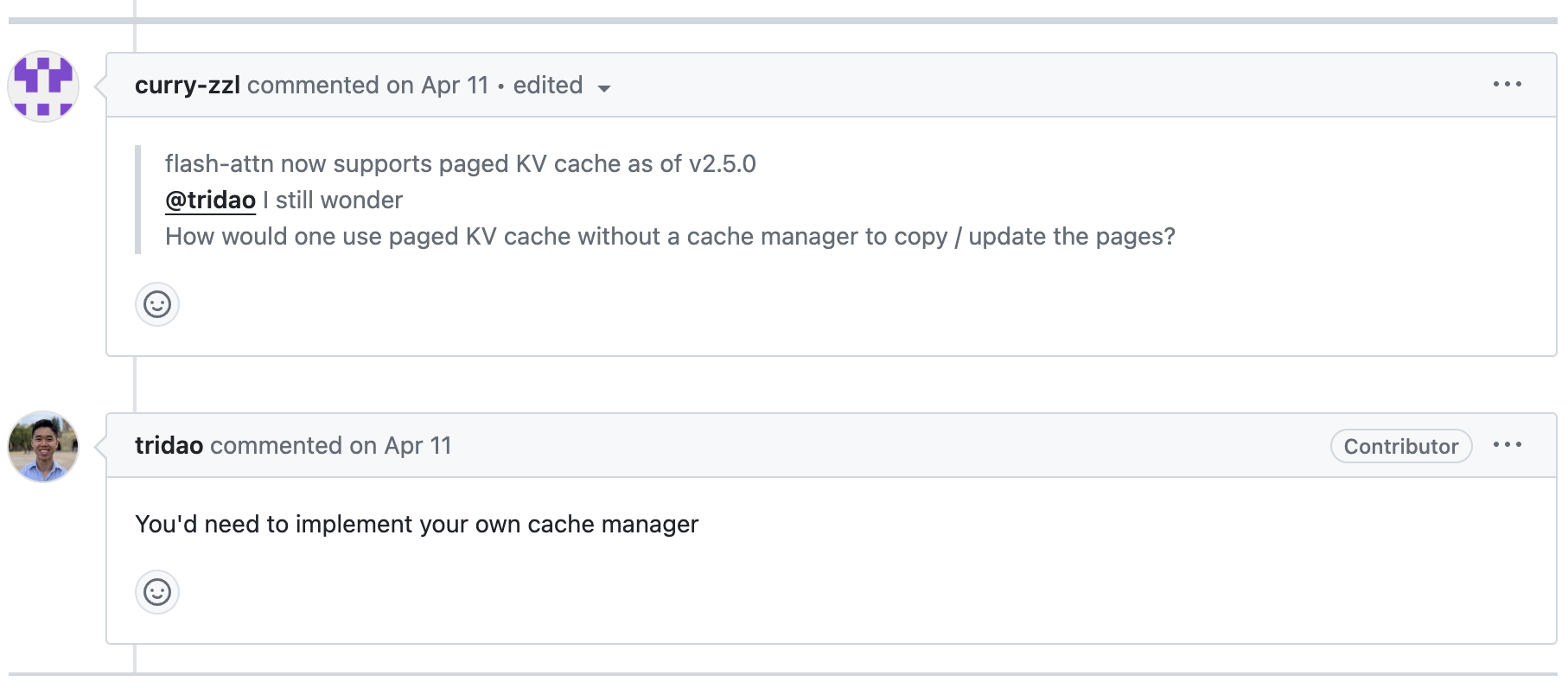A minimal PagedAttention cache manager. llama3-paged.py is a <300 line implementation of:
- LLama3 batch inference using ShareGPT prompts (
sharegpt-filtered.json). - A KV cache manager for PagedAttention.
This repo aims to show, minimally, how PagedAttention achieves larger batch sizes and higher request throughput.
To be clear, this is not a from-scratch implementation of PagedAttention. We'll use Flash Attention's PagedAttention kernel, but write our own KV cache manager as Tri Dao suggests:
Download
the pretrained weights. Here's one way using the command line, after you pip install huggingface-hub:
huggingface-cli download meta-llama/Meta-Llama-3-8B-Instruct --include "original/*" --local-dir Meta-Llama-3-8B-Instruct --token {YOUR_HF_TOKEN}pip install torch # cuda required
pip install tiktoken # for the tokenizer
pip install flash-attn --no-build-isolation # for its PagedAttention implementationGenerate responses for 4 requests using the naive method (pre-allocating the full max sequence length of the KV cache for each request):
python llama3-naive.py 4This will return 4 responses generated using Llama3.
Try increasing the number to see at which batch size OOM occurs. For my setup using a 4090 with memory size 24GB, the maximum batch size is 7 (I get an OOM with 8):
$ python llama3-naive.py 7
...
--------------------------------------------------
Fragmented Memory: 7.23 GB (28.46%)Note how ~30% of the entire GPU memory becomes fragmented and unusable. Let's see how using PagedAttention improves this.
With PagedAttention, we allocate memory only when we need to when generating tokens. This decreases fragmentation to <1%, and increases maximum batch size by 7X for me:
$ python llama3-paged.py 49
...
--------------------------------------------------
Fragmented Memory: 0.14 GB (0.57%)Note that these batch sizes are specific to my setup. If you have more GPU memory available, you will be able to use a larger batch size before you OOM. Regardless, the fact that PagedAttention will allow you to dramatically increase your batch size by decreasing memory fragmentation does not change. The benefit of PagedAttention will be apparent on any GPU device.
Traditionally, a request's KV cache is 1) stored in contiguous memory space, and 2) pre-allocated with the maximum context length (8192 for Llama3). This results in severe internal memory fragmentation e.g. if a request's actual length was generated to be 792 tokens, ~90% (=7400/8192) of the pre-allocated memory is fragmented i.e. unable to be used by any other requests.
To reduce memory fragmentation and increase request throughput (batch size), PagedAttention offers a non-contiguous KV cache memory management scheme, loosely following OS paging. This ensures that memory fragmentation only occurs at the last assigned block per request: in the diagram below, outlined in red, 3 tokens in Physical Block 3 for request A, and 2 tokens in Physical Block 2 for request B.
I also found it helpful to think about it in code. Instead of this:
y = attn(k_cache=k_cache, v_cache=v_cache, ...)PagedAttention does this:
y = paged_attn(k_cache=k_cache_paged, v_cache=v_cache_paged, block_table=block_table, ...)Unlike k_cache, k_cache_paged is non-contiguous, and is shared by all requests. Physical blocks 0~8 can be
assigned to any request, and this is why we pass in block_table, which contains the per-request assignments of the
logical blocks to physical blocks e.g. in the diagram above, block_table will look something like
{0: [7,1,3], 1: [5,2]} (0,1 being the indices for request A and B, respectively)
So who makes these assignments?
This is what I reimplement in this repo. I also added a very basic optimization: freeing blocks of finished requests such that the blocks can be used by other unfinished requests. Overall, my cache manager focuses on simplicity at the cost of performance. There are design choices that I made that makes the inference latency scale linearly with the number of requests. Shame on me. Please feel free to suggest improvements. In principle, the inference latency should be constant given any batch size.
To be fair, I made these design choices because it was enough to show the increase in request throughput using PagedAttention in <300 lines. If I made the cache manager more performant, I would probably sacrifice the minimality. However, it is important to note that performance does matter in the end, and is the reason why 8.5K LOC systems like vLLM exist.
Thanks to:
- Meta for the Llama3 code and weights
- @naklecha for the minimal (and entertaining) Llama3 inference code
- The authors of the PagedAttention paper.
- Tri Dao for the Flash Attention Repo and its PagedAttention implementation.

